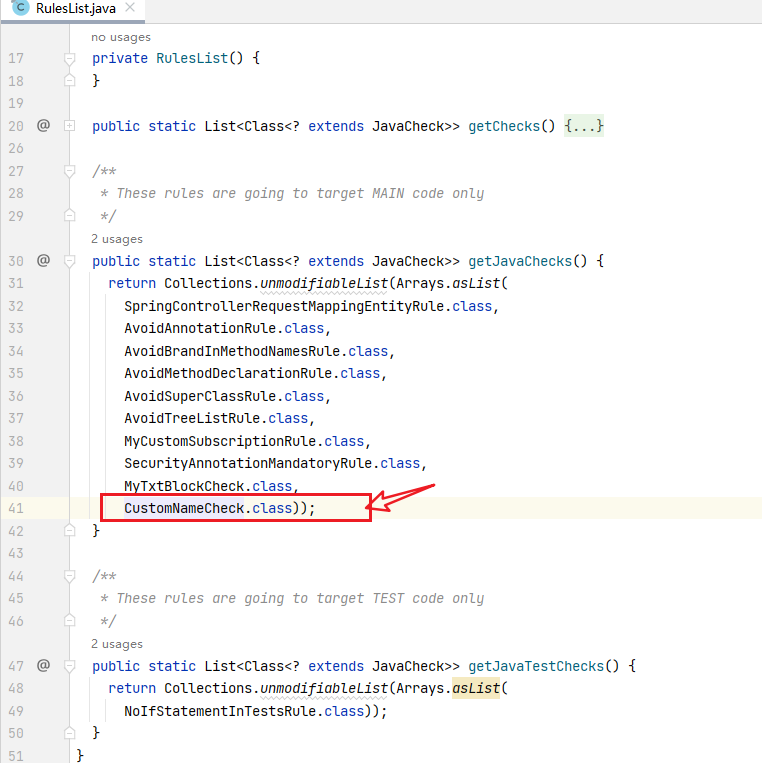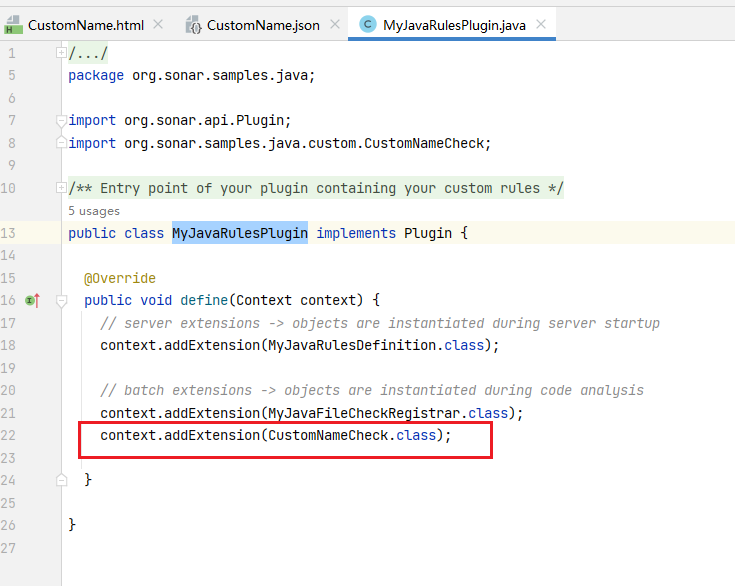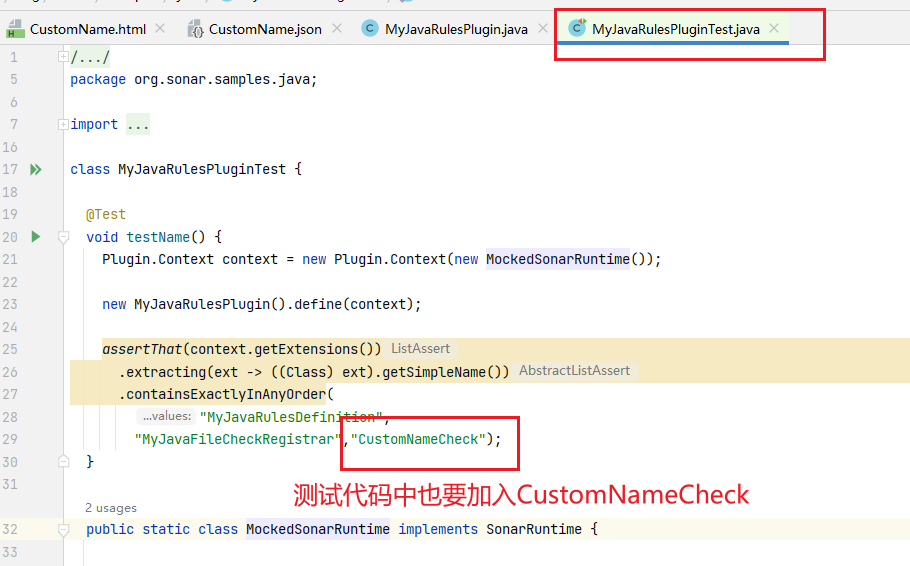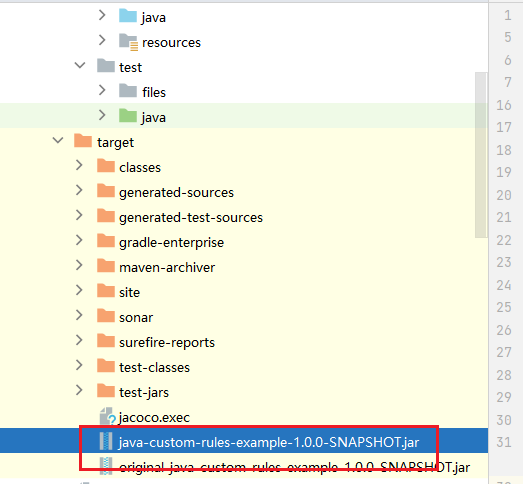sonarqube添加一条自定义规则,扫描文件中出现的username和password,方法二,使用implements Sensor
特别指出:

所以,sonarqube默认过滤掉了resources下的文件;
以下代码可以扫出yml / xml /properties 等文件中的敏感字符,当然是放在src/main下的,不是resources;
下载源码与使用详情参考:
假设你已经有了sonarqube-java源码,并且已经把sonarqube部署到电脑上;因为我的代码是基于SonarSource / sonar-java源码中示例项目docs/java-custom-rules-example
就进行如下步骤:
1、创建CustomNameCheck
package org.sonar.samples.java.custom; import org.sonar.api.batch.fs.FileSystem; import org.sonar.api.batch.fs.InputFile; import org.sonar.api.batch.fs.TextRange; import org.sonar.api.batch.sensor.Sensor; import org.sonar.api.batch.sensor.SensorContext; import org.sonar.api.batch.sensor.SensorDescriptor; import org.sonar.api.batch.sensor.issue.NewIssue; import org.sonar.api.batch.sensor.issue.NewIssueLocation; import org.sonar.api.rule.RuleKey; import org.sonar.check.Rule; import org.sonar.plugins.java.api.JavaCheck; import java.io.BufferedReader; import java.io.FileReader; import java.io.IOException; import java.util.regex.Pattern; @Rule(key = "CustomName") //@Rule(key = "CustomName",name = "Custom Sensitive Information Rule txt txt",description = "ddddddddddddddddddddddddddd",tags = { "bugs", "gandalf", "magic"},priority = Priority.CRITICAL) public class CustomNameCheck implements Sensor ,JavaCheck{ private static final Pattern SENSITIVE_PATTERN = Pattern.compile(".*(username|password).*", Pattern.CASE_INSENSITIVE); // private final FileSystem fs; @Override public void describe(SensorDescriptor descriptor) { // System.out.println("------------------------------describe--"); descriptor.name("Hardcoding is not allowed, username or password") .onlyOnLanguage("java"); } @Override public void execute(SensorContext context) { // System.out.println("------------------------------execute--"); FileSystem fileSystem = context.fileSystem(); Iterable<InputFile> inputFiles = fileSystem.inputFiles(fileSystem.predicates().all()); String absolutePath; for(InputFile input:inputFiles ){ absolutePath = input.absolutePath(); try { scanFile(input,context,absolutePath); } catch (IOException e) { throw new RuntimeException(e); } } } private void scanFile(InputFile inputFile, SensorContext context,String absolutePath) throws IOException { // System.out.println("---------------------scanFile----" + absolutePath); try(BufferedReader reader = new BufferedReader(new FileReader(absolutePath))) { String line; int lineNumber = 0; while ((line = reader.readLine()) != null) { lineNumber++; if (SENSITIVE_PATTERN.matcher(line.toLowerCase()).matches()) { NewIssue newIssue = context.newIssue().forRule(RuleKey.of("mycompany-java", "CustomName")); TextRange range = inputFile.newRange(lineNumber, 0, lineNumber, line.length()); NewIssueLocation newIssueLocation = newIssue.newLocation() .on(inputFile) .message("Hardcoding is not allowed, username or password").at(range); newIssue.at(newIssueLocation).save(); } } } } }
2、将CustomNameCheck 加入到RulesList

3、编写.html .json文件
CustomName.html如下
<!DOCTYPE html> <html> <head> <title>Custom Sensitive Information Rule - implements Sensor</title> </head> <body> <h1>Sensitive Information Rule TXT TXT</h1> <p>This rule detects hardcoded sensitive information such as 'username' or 'password' in the code.</p> <h2>Rule Description</h2> <p>Hardcoding sensitive information can lead to security vulnerabilities and is considered a bad practice. This rule helps identify such cases in your codebase.</p> <h2>Examples</h2> <h3>Non-compliant Code</h3> <pre> private static final String username = "myUsername"; private static final String password = "myPassword"; </pre> <h3>Compliant Code</h3> <pre> private static final String someValue = "value"; // Use configuration files or environment variables </pre> <h2>Best Practices</h2> <ul> <li>Do not hardcode sensitive information in your codebase.</li> <li>Use configuration files or environment variables to manage sensitive data securely.</li> </ul> </body> </html>
CustomName.json如下
{ "title": "Custom Sensitive Information Rule - implements Sensor", "type": "Bug", "status": "ready", "tags": [ "bugs", "gandalf", "magic" ], "defaultSeverity": "Critical" }
4、将CustomNameCheck 加入到MyJavaRulesPlugin
(为什么要把CustomNameCheck 加入到MyJavaRulesPlugin? 我也不知道,只是如果不加入,扫描时无法使用这条规则)

5、测试代码也要加入,不然打包会报错;

5、打包
mvn clean install -f .\pom_SQ_9_9_LTS.xml
6、将新生成的jar放到sonarqube\安装目录\extensions\plugins,然后重启项目

接下来如何在sonarqube使用这些规则?请参考:
SonarQube使用新增的自定义规则,进行maven项目扫描 - yxchun - 博客园 (cnblogs.com)




【推荐】国内首个AI IDE,深度理解中文开发场景,立即下载体验Trae
【推荐】编程新体验,更懂你的AI,立即体验豆包MarsCode编程助手
【推荐】抖音旗下AI助手豆包,你的智能百科全书,全免费不限次数
【推荐】轻量又高性能的 SSH 工具 IShell:AI 加持,快人一步
· TypeScript + Deepseek 打造卜卦网站:技术与玄学的结合
· Manus的开源复刻OpenManus初探
· AI 智能体引爆开源社区「GitHub 热点速览」
· 从HTTP原因短语缺失研究HTTP/2和HTTP/3的设计差异
· 三行代码完成国际化适配,妙~啊~